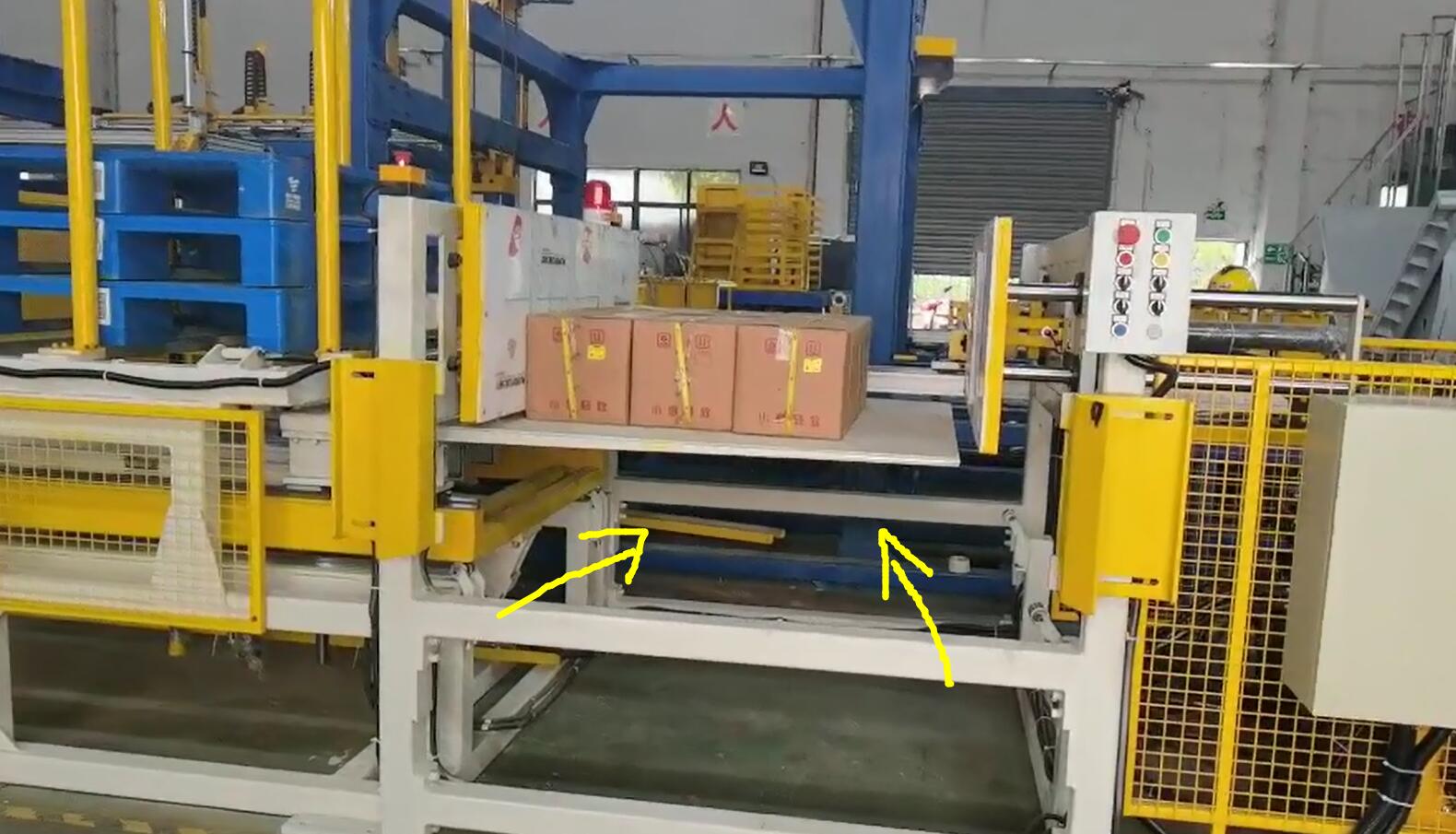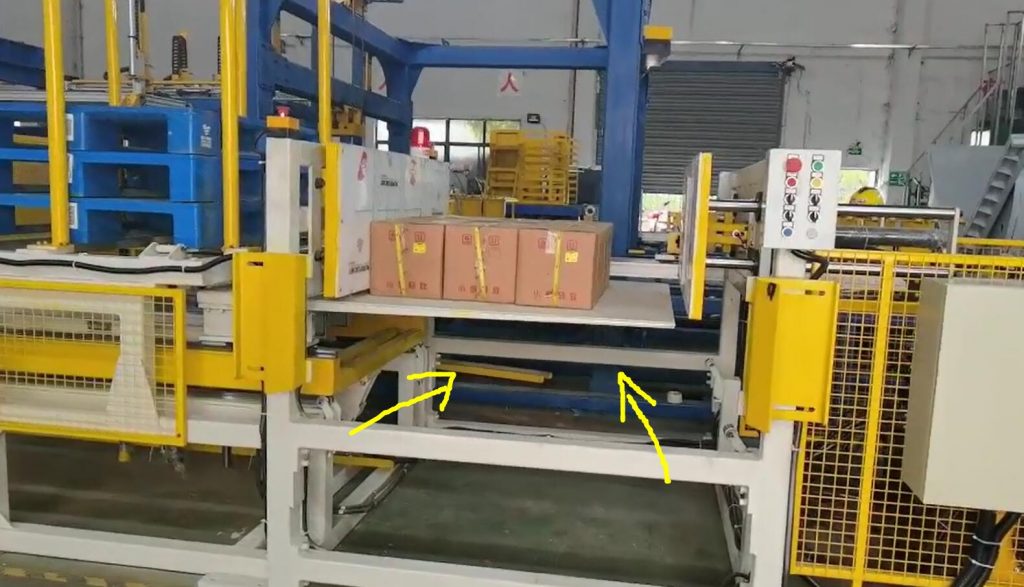1. Introduction: Streamlining Pallet Exchange with Push-Pull Technology
In modern warehousing and logistics, the efficient and safe handling of palletized goods is paramount. The push-pull pallet transfer machine, also known as a pallet changer or pallet exchange system, represents a significant advancement in automating the process of swapping pallets beneath a load. This is particularly crucial when dealing with internal vs. external pallet requirements, hygiene regulations (e.g., wood to plastic), or integrating loads into automated systems. The machine demonstrated in the video excels in handling loads like paper boxes, where maintaining orientation and stability during transfer is critical. Unlike traditional pallet inverters, this solution achieves pallet exchange without needing to tilt or rotate the entire load, offering distinct advantages for sensitive or unstable products.
2. Operational Principle: How the Push-Pull Pallet Changer Works
The core mechanism of this type of pallet transfer machine relies on a gentle yet firm push-pull action combined with secure load stabilization:
- Loading: A forklift places the loaded pallet onto the machine's platform.
- Clamping: Adjustable side walls gently close in to secure the load, preventing shifting during the transfer. The pressure is carefully controlled to avoid product damage.
- Push Plate Engagement: A robust push plate advances horizontally, moving behind the load and just above the original pallet.
- Pallet Exchange: As the push plate supports the load's weight, the original pallet can be withdrawn (manually or automatically). Simultaneously or sequentially, the new target pallet is positioned beneath the load.
- Load Lowering/Transfer: The push plate retracts smoothly, gently lowering the load onto the new pallet.
- Release and Unloading: The side clamps retract, and the newly palletized load can be removed by a forklift.

This process ensures the load remains upright and stable throughout, minimizing the risk of damage associated with rotation or inversion.
3. Key Design Features and Structural Components
Understanding the components provides insight into the machine's capabilities and reliability:
- Heavy-Duty Steel Frame: Provides structural integrity and stability to handle significant load weights.
- Hydraulic Power Unit: Drives the clamping mechanism and the push-pull plate, ensuring smooth and controlled movements.
- Adjustable Clamping Walls: Often lined with protective material, these walls accommodate various load dimensions and provide secure, non-damaging stabilization.
- Push-Pull Plate: The core component that supports the load during transfer. Its design ensures even weight distribution.
- PLC Control System: (Programmable Logic Controller) Manages the operational sequence, timings, and safety interlocks. Often paired with an HMI (Human-Machine Interface) touchscreen for easy operation and diagnostics.
- Safety Features: Typically includes light curtains, emergency stops, and physical guarding to protect operators.
- Conveyor Integration (Optional): Can be integrated with roller or chain conveyors for fully automated line operations.
![Image placeholder - consider adding an image of the machine's control panel or clamping mechanism with descriptive alt text like 'PLC control panel for push-pull pallet changer' or 'Hydraulic side clamps securing paper boxes on pallet transfer machine']
4. Technical Specifications Comparison (Typical Data)
While exact specifications vary by manufacturer and model, the following table provides representative data for push-pull pallet transfer machines:
| Feature | Specification (Typical Range) | Notes |
|---|---|---|
| Load Capacity | 1200 kg - 2000 kg (2645 - 4400 lbs) | Higher capacities available on request |
| Max Load Dimensions | Up to 1200x1200 mm base, 2400 mm H | Highly customizable |
| Cycle Time | 45 - 90 seconds | Dependent on load, automation level |
| Machine Footprint | Approx. 3m x 2.5m x 3m (L x W x H) | Varies significantly with configuration |
| Control System | PLC with Touchscreen HMI | Common brands: Siemens, Allen-Bradley |
| Power Requirements | 380-480V / 50-60Hz / 3-Phase | Check specific model for local standards |
| Clamping Method | Hydraulic Side Pressure | Pressure adjustable for different loads |
| Operation Mode | Semi-automatic or Fully Automatic | Integration options affect automation level |
5. Benefits and Ideal Applications
Employing a push-pull pallet changer offers several operational advantages:
- Preserves Load Orientation: Essential for products sensitive to tilting or rotation (e.g., liquids, layered goods, unstable stacks like paper boxes).
- Reduces Product Damage: Gentle handling minimizes stress and potential damage compared to inversion methods.
- Enhances Throughput: Faster cycle times compared to manual methods or full inversion for certain applications.
- Improves Hygiene: Facilitates easy transfer from wooden pallets (warehouse) to plastic/hygienic pallets (production/cleanroom).
- Increases Safety: Automates a potentially hazardous manual task, reducing risks of worker injury.
- Versatility: Can handle a wide range of load types and sizes with adjustable clamping.
Ideal Applications Include:
- Food and Beverage industries (hygiene requirements, fragile packaging)
- Pharmaceuticals and Chemicals (cleanroom standards, stable handling)
- Paper and Printing industries (preventing shifting of stacked paper/boxes)
- Logistics and Distribution centers (managing different pallet types)
- Automated Storage and Retrieval Systems (AS/RS) integration
6. Comparison with Pallet Inverters
It's useful to compare the push-pull changer with its main alternative, the pallet inverter.
- Push-Pull Pallet Changer:
- Pros: No load rotation (maintains orientation), generally faster for stable loads, suitable for fragile/unstable items.
- Cons: May exert some side pressure, requires precise alignment.
- Pallet Inverter:
- Pros: Can handle a very wide range of load stabilities (once clamped), useful for accessing bottom layers or replacing damaged goods within a stack.
- Cons: Rotates/inverts the load 180 degrees, potentially unsuitable for liquids or orientation-sensitive products, may have slightly longer cycle times.
The choice depends heavily on the specific product characteristics and operational needs.
7. User Experience and Implementation Insights
From a practical standpoint, integrating and using a push-pull pallet changer involves several considerations:
- Space Requirements: Ensure adequate floor space for the machine and maneuvering room for forklifts.
- Integration: Assess how the machine fits into the existing workflow. Will it be a standalone station or part of an automated line?
- Operator Training: While often automated, operators need training on safe operation, loading/unloading procedures, and basic troubleshooting via the HMI.
- Maintenance: Regular hydraulic system checks, sensor cleaning, and lubrication are crucial for reliable performance. A preventative maintenance schedule is recommended.
- Load Suitability: While versatile, extremely irregular or fragile loads might require specific testing or adjustments to the clamping pressure and push-plate speed.
Personal experience suggests that proper setup and operator familiarity are key to maximizing the efficiency and safety benefits of these machines. The intuitive HMI controls on modern units greatly simplify operation and diagnostics.
8. Conclusion: An Efficient Solution for Non-Rotational Pallet Exchange
The push-pull pallet transfer machine provides a valuable, efficient, and safe solution for exchanging pallets without disturbing the load's orientation. As demonstrated with paper box loads, its ability to maintain stability while performing the transfer makes it ideal for industries where product integrity and specific handling requirements are critical. By understanding its operational principles, technical specifications, and benefits compared to alternatives like pallet inverters, businesses can make informed decisions to optimize their material handling processes, improve safety, and enhance overall supply chain efficiency.
For more information on various pallet changing solutions, including different types of machines, visit: https://www.fhopepack.com/pallet-inverter/


